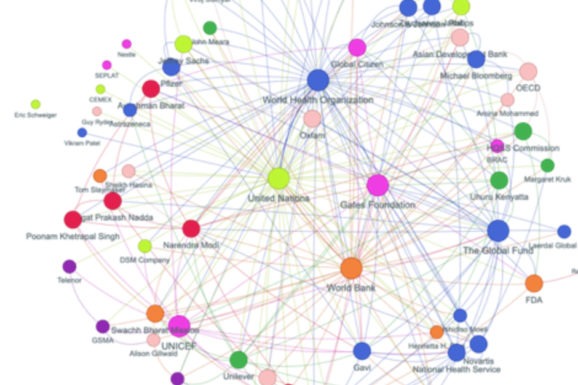For the July Map of the Month series, Handshake analyzed the networks of two of the most prominent UN Sustainable Development Goals:
- SDG 3: Ensure Healthy Lives and Promote Well-Being for All at All Ages
- SDG 6: Ensure Availability and Sustainable Management of Water and Sanitation for All
We looked at these two networks because Health and Water are tightly connected when fostering greater social and economic development, as it is virtually impossible to achieve positive health outcomes without providing people with access to clean and safe water.

STRENGTH SCORE 2.31

STRENGTH SCORE: 1.77
In analyzing both networks, Handshake found that SDG 3 is a stronger network than SDG 6. In a strong network, influence is built and reputations are strengthened by tapping into an existing community of innovators and contributing to the central discussions that are most relevant to this community[1].
In a weak network, the infrastructure needed to build influence and reputation does not exist and the barriers to entry are higher. A small set of dominant actors control the narrative and prevent its organic growth within the community. Oftentimes, these networks lack additional conveners who can connect innovative voices and tie together multiple trends within a topic.
Based on our analysis of the networks of SDG 3 and SDG 6, we developed the following insights:
- The community around Health is far more interconnected and open to innovation than that of Water.
- If someone is not yet present in either network, focusing on Health will prove easiest to scale their impact and become a trusted voice within that community.
- Bringing new ideas and best practices to the Water network will be challenging, but it can be done if an organization is willing to invest the time and resources to the issue over a sustained period of time. So-called “quick wins” are hard to achieve in the Water network as it is quite hierarchical.
Strategy to Engage SDG 3
- Looking at Health, its network strength score is bolstered primarily by a high degree of interconnectivity and redundancy. Many organizations and individuals are trying to make an impact on similar subtopics within the overall topic of Health, which often creates an overlap across efforts. While competing interests and perspectives increase the diversity of views, a greater degree of specialization and focus is needed to achieve impact.
- Building on the insight above, it is clear that while the network around Health is quite dense and specialized, it is not very inclusive. There is room for innovative voices on the periphery to be brought into these important conversations.
Strategy to Engage on SDG 6
- The strongest insight into the development community around Water draws the link between the amount of resources and level of engagement. Actors who are more engaged with the topic are also devoting substantial resources and time to it.
- The greatest weakness around the Water network is its dependence on a few central gatekeepers who have the most credibility and resources. This creates a more hierarchical network, perhaps more efficient at focusing resources on a given solution but not at capturing innovation and scaling new ideas in order to create impactful solutions.
Building a Pathway to Achieve Influence Across Both Topics
Those looking to scale their impact may want to consider engaging with both Health and Water issues. While the two topics are closely intertwined, many organizations do not believe that this connection will force them to make an either/or decision. Rather, they consider this a question around when/how Health and Water should go hand-in-hand in developing a sustainable and inclusive society.
By layering both networks on top of one another, we identified the actors in each network who are in the best position to scale impact across these issues, while creating a more innovative community through this process.
Across the subtopics within SDG 3 and SDG 6, we have identified the top five who are most central across both networks and have the greatest number of shared actors and focus areas. This includes:
Health Network:
- Family Health
- National Policy
Water Network:
- Access
- Conservation
- Sanitation
Our analysis shows that if individuals and organizations want to quickly make a strong impact on Health or Water issues, taking a dual approach may work best. In other words, they should not focus on family health in isolation, but instead take a comprehensive approach, as they cannot improve family health without providing access to safe water.
The Benefits of Comparing Networks
Handshake’s methodology of assigning scores to networks allows us to assess how easy or challenging it will be for an individual or organization to influence the conversations, ideas and outcomes around a particular topic. In our highly connected, global society, issues such as poverty alleviation, clean water access and social progress are not isolated objectives. Rather, they are a culmination of a series of objectives that when achieved through collective efforts, can lead to healthier and better lives.
Many of these networks are connected in some form or another, and therefore it is important to take a holistic approach when setting a strategy to engage a network. By looking at networks as intertwined rather than isolated, there is a greater ability to take existing resources, knowledge, and credibility from one network and apply it to others – thereby scaling your influence.
[1] Handshake’s Network Strength Score is compiled by taking the ratios of strong indicators and dividing them over ratios of weak indicators. Because 99% of results fall between 0 and 3, the range in Handshake’s scoring model is between 0 and 3.
